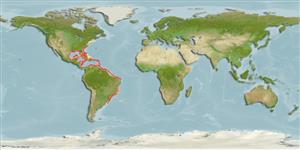Environment: milieu / climate zone / depth range / distribution range
Ecologia
marinhas demersal; oceanódromo (Ref. 51243); intervalo de profundidade 55 - 525 m (Ref. 5222). Tropical; 43°N - 34°S, 98°W - 35°W
Western Atlantic: Massachusetts, USA to the Gulf of Mexico, Cuba, Trinidad, Rio de Janeiro and Sao Paulo (Ref. 47377), Brazil. Rare in the West Indies (Cuba, Haiti, and Trinidad). Reports from the eastern Pacific are apparently misidentifications of Epinephelus exsul.
Tamanho / Peso / Idade
Maturity: Lm ? range ? - ? cm
Max length : 230 cm TL macho/indeterminado; (Ref. 5222); peso máx. publicado: 198.1 kg (Ref. 4699); idade máx. registrada: 91 anos (Ref. 127586)
Espinhos dorsais (total) : 10; Raios dorsais (total) : 13 - 15; Espinhos anais: 3; Raios anais : 9. Distinguished by the following characteristics: dark reddish brown or brownish grey to almost black dorsally, dull reddish grey below; depth of body contained 2.4-2.6 times in SL; head length 2.1-2.5 times in SL; distinctly convex interorbital area; angular preopercle, rounded angle, with slightly enlarged serrae and with 1-2 small spines on lower edge just in front of angle; smooth interopercle and subopercle; subequal nostrils, posterior nostrils slightly larger; maxilla reaches well past eye; 4-5 rows of small teeth on midside part of lower jaw in adults and juveniles with 2-3 rows (Ref. 89707).
A solitary species (Ref. 26340) usually found on rocky bottoms; juveniles are occasionally seen on jetties and shallow reefs (Ref. 89707). Adults feed on a variety of crabs, shrimps, lobsters, and fishes. Marketed fresh.
Ciclo de vida ou comportamento de acasalamento
Maturidade | Reprodução | Desova | Ovos | Fecundidade | Larvas
Craig, M.T. and P.A. Hastings, 2007. A molecular phylogeny of the groupers of the subfamily Epinephelinae (Serranidae) with revised classification of the epinephelini. Ichthyol. Res. 54:1-17. (Ref. 83414)
Status na Lista Vermelha da UICN (Ref. 130435: Version 2024-1)
Ameaça para os humanos
Harmless
Uso pelos humanos
Pescarias: espécies comerciais; peixe esportivo: sim
Ferramentas
Relatórios especiais
Baixar XML
Fontes da internet
Estimates based on models
Preferred temperature (Ref.
123201): 13.8 - 23.1, mean 18.3 °C (based on 82 cells).
Índice de diversidade filogenética (Ref.
82804): PD
50 = 0.5001 [Uniqueness, from 0.5 = low to 2.0 = high].
Bayesian length-weight: a=0.01318 (0.00685 - 0.02536), b=3.05 (2.89 - 3.21), in cm total length, based on LWR estimates for this species & Genus-body shape (Ref.
93245).
Nível Trófico (Ref.
69278): 4.0 ±0.61 se; based on food items.
Resiliência (Ref.
120179): Baixo, tempo mínimo de duplicação da população 4,5 - 14 anos (K=0.05-0.14; tmax=24).
Fishing Vulnerability (Ref.
59153): Very high vulnerability (85 of 100).
Climate Vulnerability (Ref.
125649): High to very high vulnerability (75 of 100).
Nutrients (Ref.
124155): Calcium = 40.6 [19.0, 78.0] mg/100g; Iron = 0.705 [0.364, 1.349] mg/100g; Protein = 18.1 [16.2, 19.8] %; Omega3 = 0.233 [0.128, 0.425] g/100g; Selenium = 129 [65, 268] μg/100g; VitaminA = 8.85 [3.12, 28.03] μg/100g; Zinc = 0.619 [0.422, 0.939] mg/100g (wet weight);
